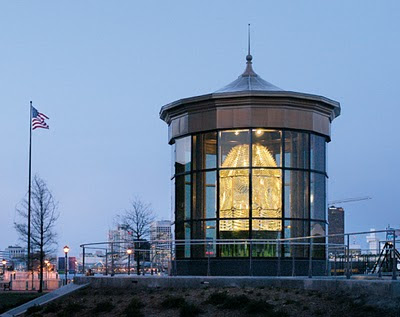 |
| The Hog Island First order Fresnel lens on the Portsmouth, Virginia waterfront. |
"Shine on", guiding light--
I see your lighted beacon, shining "bright".
Your light is strong, shining bold and bright--
It can be seen for many miles, your "guiding" light.
Whether arriving from the sea, or standing real near--
Your light shines bright,
dissolving all "sense" of fear.
"Shine on", guiding light--
I feel safe, with a sense of home,
when I see your "bright" beacon light.
From the poem "Shine On" by Snow W. Frost
I see your lighted beacon, shining "bright".
Your light is strong, shining bold and bright--
It can be seen for many miles, your "guiding" light.
Whether arriving from the sea, or standing real near--
Your light shines bright,
dissolving all "sense" of fear.
"Shine on", guiding light--
I feel safe, with a sense of home,
when I see your "bright" beacon light.
From the poem "Shine On" by Snow W. Frost
 |
| The Hog Island Pavilion stands sentinel on the Portsmouth, Virginia seawall in front of the historic Seaboard building that houses Skipjack Nautical Wares & Marine Gallery. |
The lens, the second largest lighthouse lens in the U.S., stands 10 feet tall and weighs 2,500 pounds. 368 prisms make up the reflective body of the lens.
 |
| Hog Island lighthouse lens is the second largest in the U.S. |
The structure that houses the lens was designed to simulate the lantern room of a lighthouse is 16 feet in diameter and is approximately 25 feet from the floor of the pavilion to the top of the spire and the lens can be viewed from 360 degrees through the pavilion windows. The platform surrounding the structure is raised 4 feet above the surrounding grade to give the lens more prominence. Stairs and a handicapped accessible ramp access the raised platform.The lens is mounted on a turntable that rotates slowly, much as it once turned at the top of the Hog Island Lighthouse. Spotlights mounted at the ceiling of the pavilion reflect off the lens’ prisms creating a magnificent scene at night as the lens sparkles and shines.
The lens is on loan to the City of Portsmouth from the United States Coast Guard, and HBA was hired by the City to design a pavilion to preserve and showcase the valuable, first-order Fresnel lens.
 |
| Original Hog Island lighthouse on Virginia's eastern shore. |
HISTORY
The first Hog Island Lighthouse was built in 1852 and was a white conical brick tower. This lighthouse lasted until 1896 when it was replaced with a cast iron pyramidal skeletal tower with a central cylinder. This lighthouse was similar to the Cape Charles lighthouse today.
Both lighthouses were built on what was the southern end of Hog Island. Hog Island was the northern most part of the natural barrier islands of Virginia’s Eastern Shore.
By the 1920s the ocean had eroded much of the island. A hurricane in the 1930s claimed even more of the land. The lighthouse was demolished in 1948.
The 10-foot high lens, a first order produced by the Henry-LePaute company in France, was removed from the lighthouse before its final destruction. It is now on display on the Portsmouth Seawall adjacent to the High Street Landing. for more information and a printable brochure, click on this link.

Comments
Post a Comment